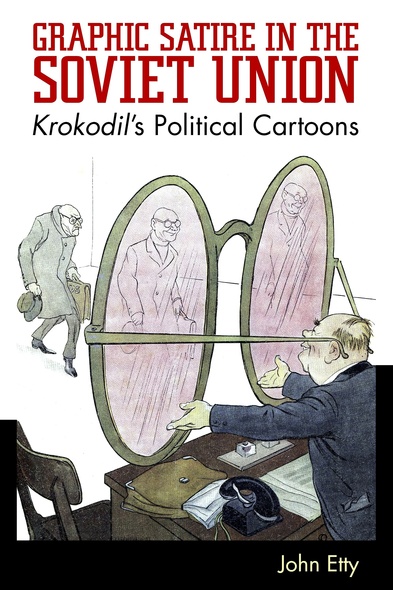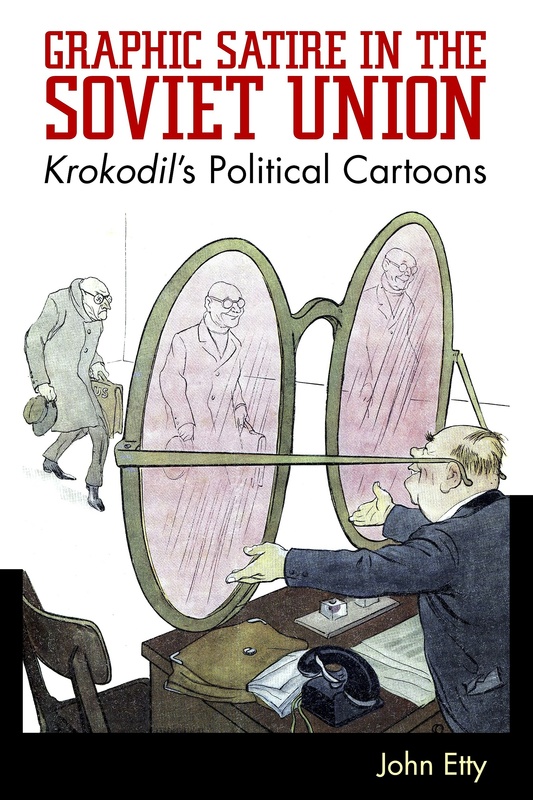
Graphic Satire in the Soviet Union
Krokodil's Political Cartoons
After the death of Joseph Stalin, Soviet-era Russia experienced a flourishing artistic movement due to relaxed censorship and new economic growth. In this new atmosphere of freedom, Russia’s satirical magazine Krokodil (The Crocodile) became rejuvenated. John Etty explores Soviet graphic satire through Krokodil and its political cartoons. He investigates the forms, production, consumption, and functions of Krokodil, focusing on the period from 1954 to 1964.
Krokodil remained the longest-serving and most important satirical journal in the Soviet Union, unique in producing state-sanctioned graphic satirical comment on Soviet and international affairs for over seventy years. Etty’s analysis of Krokodil extends and enhances our understanding of Soviet graphic satire beyond state-sponsored propaganda.
For most of its life, Krokodil consisted of a sixteen-page satirical magazine comprising a range of cartoons, photographs, and verbal texts. Authored by professional and nonprofessional contributors and published by Pravda in Moscow, it produced state-sanctioned satirical comment on Soviet and international affairs from 1922 onward. Soviet citizens and scholars of the USSR recognized Krokodil as the most significant, influential source of Soviet graphic satire. Indeed, the magazine enjoyed an international reputation, and many Americans and Western Europeans, regardless of political affiliation, found the images pointed and witty. Astoundingly, the magazine outlived the USSR but until now has received little scholarly attention.
Graphic Satire in the Soviet Union provides a wealth of information about the intersection between graphic art, politics, and Soviet culture that would be of interest to any postgraduate academic interested in Russian history, Cold War history, graphic satire, poststructuralism, or Russian culture and politics.
Theoretically astute, the book draws on cultural studies and linguistic theory, and provides useful conceptual tools for readers interested in the analysis of graphic satire and Soviet visual culture in general. . . . Etty masterfully connects rigorous historical explorations with a great sensibility to the workings of satirical representation.
This highly sophisticated and intellectually exciting study is a tour de force of visual and political analysis that overturns traditional notions of Cold War strategies. Etty surveys the long-lasting satirical magazine Krokodil (1922–2000; 2005–2008) as an officially approved publication lampooning the execrated West but also selectively criticizing aspects of Soviet life. He concentrates on the Thaw era, tackling the issue of the magazine’s Sovietism from multiple perspectives even as, with the illuminating aid of Bakhtin, he moves far beyond the conventional wisdom of Krokodil as pure propaganda. With cartoons by such celebrated graphic satirists as the Kukryniksy and Ivan Semenov, the study engages transmedia theory while rigorously adhering to a nonpartisan, historically informed base that takes into account the publication’s telos, patterns of production, aesthetic/humorous considerations, and audience reception. The impeccable scholarship alone is worth the price of the book, though the conclusion serves as a superlative summation not to be missed. Teeming with insights and rigorously argued, Graphic Satire in the Soviet Union is indisputably one of the most riveting monographs in Slavic studies to appear in the last few years.
A fascinating, lavishly illustrated, often astonishing study of Soviet Russia’s key satirical journal with the focus where it belongs: its brilliant cartoons. Etty’s reading of Krokodil through a Bakhtinian lens, as a form of Menippean satire, proves fabulously productive and illuminating; his scrutiny of the decade after Stalin’s death, meanwhile, plugs a hole in the scholarship of Soviet caricature and visual culture that needed filling. It delights me to no end that this book will bring further attention to such great Soviet-era cartoonists as Boris Efimov, Iulii Ganf, and the Kukryniksy—names as familiar to Russian readers as Charles Schulz, Al Capp, and Herblock are in the US.
John Etty is Head of Faculty (Social Science) and Head of Department (History) at Auckland Grammar School in New Zealand. He has published in the edited volumes Russian Aviation, Space Flight, and Visual Culture and Russian Culture in the Age of Globalization and in such journals as Slavic Review, History Review, the International Journal of Comic Art, and Slovo.




